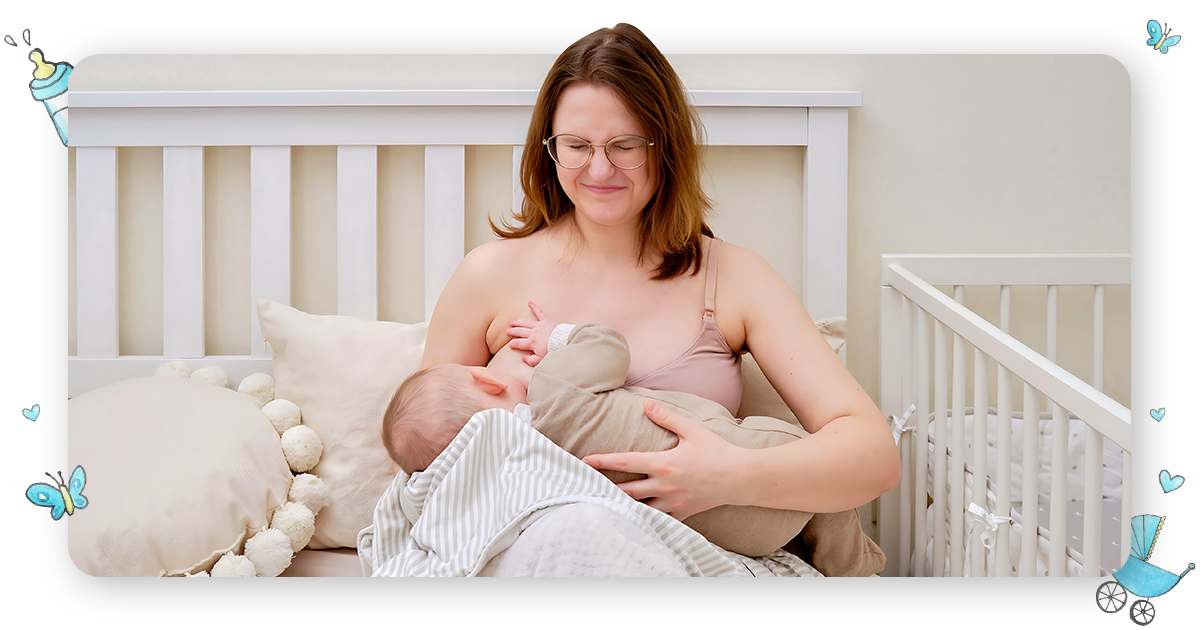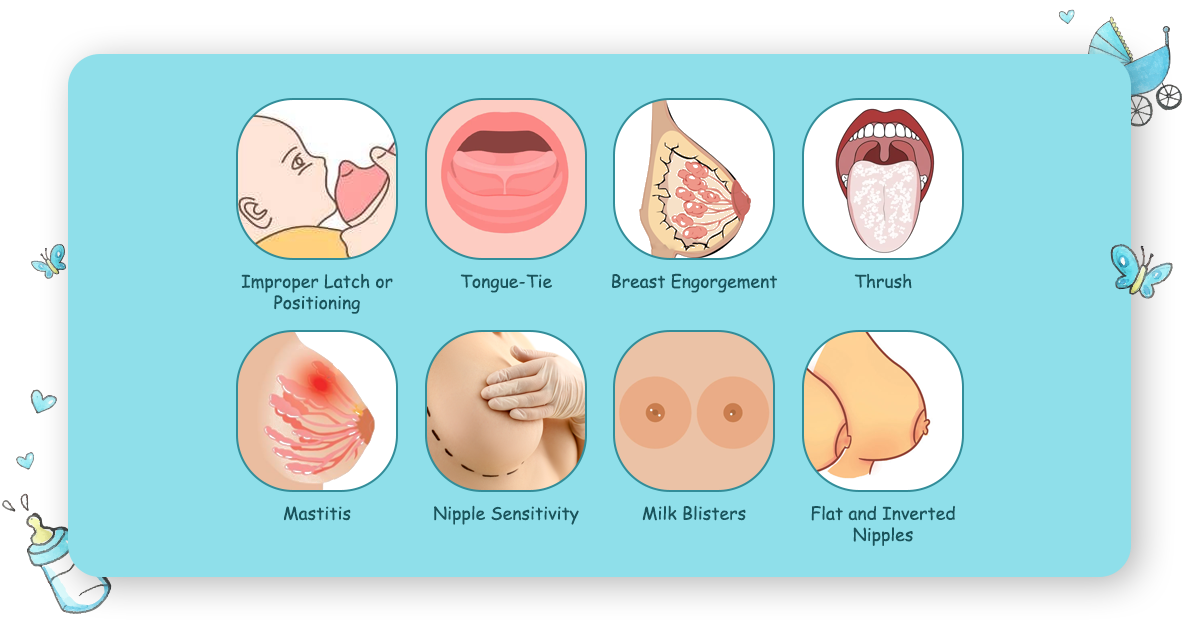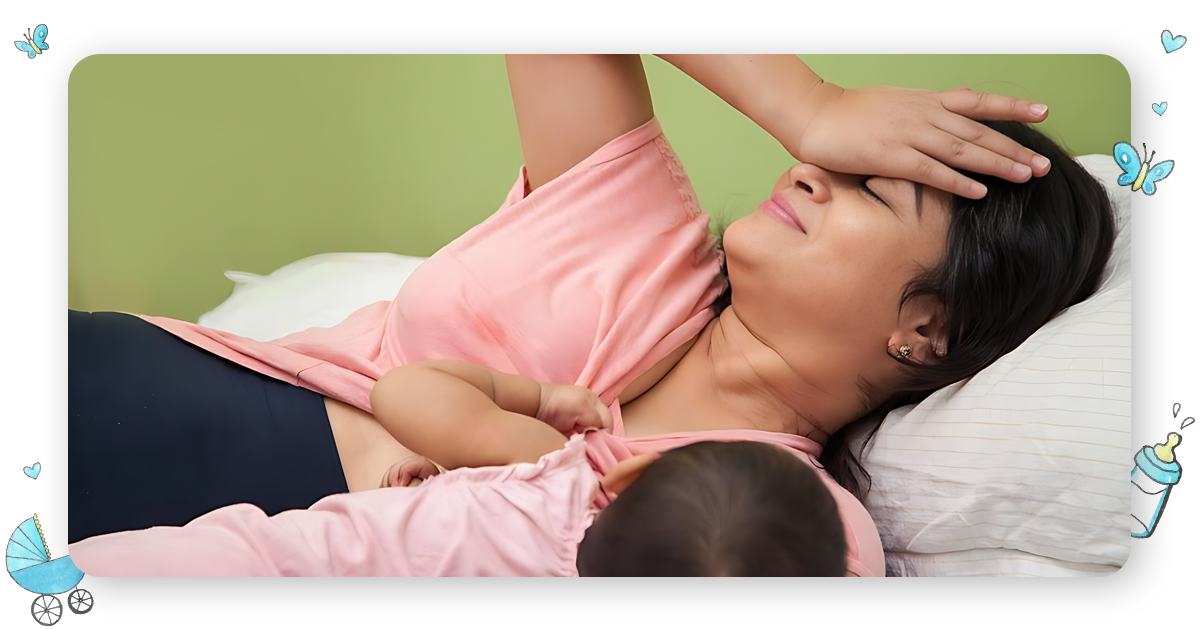Nipple Pain During Breastfeeding: Causes, Symptoms, Prevention, and Treatment

Babies receive the most nutrition from their mother’s milk. That’s the reason why so much…
Babies receive the most nutrition from their mother’s milk. That’s the reason why so much importance is laid on breastfeeding. It ensures every baby receives proper nutrition that keeps them healthy and away from sicknesses.
Understanding More About Nipple Pain
While breastfeeding is one of the best ways for a mother and her child to bond, it does come with some challenges and discomforts. Nipple pain is one of them. If you, too, are facing this issue, let me tell you, you’re not alone!
Most new moms experience some amount of nipple pain and soreness during the first few days of breastfeeding, which does get better with time. For some, it may continue longer. Hence, it is vital to know its causes and ways to prevent or treat it so you can enjoy a pain-free nursing experience.
What Causes Nipple Pain During Breastfeeding?
Several causes can result in tender and sore nipples. Your nipple pain could be due to just one reason, or it could result from multiple causes. Only when you identify and treat the underlying cause will you be able to start feeling better. So, let’s look at the various causes leading to nipple pain:

1. Improper Latch or Positioning
This is the most common reason behind nipple pain while breastfeeding. When your baby is not in a position that supports proper breastfeeding, you are bound to feel pain and discomfort.
Improper positioning leads to poor attachment of the baby to the breast. And because the baby cannot latch properly, the nipples are subjected to more chafing and friction, resulting in discomfort.
2. Tongue-Tie
A baby with a short frenulum, or tongue-tie, cannot correctly curve their tongue around the nipple. This results in a poor latch, because of which the baby has to rub the nipple harder to express milk. Frequent and excessive rubbing leaves the nipples sore and tender.
3. Breast Engorgement
Engorged breasts can also add to existing nipple pain. During the initial breastfeeding days, your breasts adjust their milk supply depending on the baby’s needs.
But it could lead to engorgement if your breast produces too much milk at once. Going without feeding your baby for too long can also cause engorgement, making it difficult for your little one to latch on, and a poor latch causes nipple pain.
4. Thrush
A baby with thrush (yeast infection) could pass the infection to the mother. If you observe cracks at the corners of your baby’s mouth or visible white and yellow patches inside the mouth, they could be having thrush.
And how would you know if it’s the thrush that’s causing pain in your nipples? Look for signs such as sharp pains during feedings, excessive redness, shiny and flaky nipples, and itchy and cracked nipples.
5. Mastitis
Blocked milk ducts can also be a reason behind inflammation of breast and nipple pain. When milk fails to ooze out freely of the breasts, it results in milk build-up leading to pain, swelling, and discomfort. Mastitis also presents other symptoms like fever and body ache that require a doctor’s attention.
6. Nipple Sensitivity
This is another common reason for nipple pain. New moms often experience pins and needles feeling for the first few seconds when their baby begins the feed. It does get better as the session continues and may last for a week or so post-partum.
7. Milk Blisters
If you ever see a white or yellow spot on your nipple with some skin covering it, it could be a milk blister. A milk blister causes pain in the nipple because it blocks a milk duct, causing the build-up of milk and preventing it from flowing out.
8. Flat and Inverted Nipples
Moms with flat or inverted nipples may suffer from soreness because it makes it harder for a baby to attach appropriately to the breast forcing them to rub harder against the nipple to draw milk.
In addition to the above causes, allergic reactions to soaps, lotions, and detergents, skin conditions such as dry skin and eczema, teething, and the inappropriate use of breast pumps are also known to cause nipple pain in breastfeeding mothers.
Signs and Symptoms of Nipple Pain
As a new mom, you may experience one or more symptoms of nipple pain.

Here are the signs and symptoms associated with this uncomfortable condition:
How Can Breastfeeding Mothers Prevent Nipple Pain?
Nipple pain is part and parcel of breastfeeding. As mentioned, most new moms go through it as they and their little ones learn the art of nursing. With time, nipple pain subsides, but while you’re still at it, you can take a few preventative measures to support yourself.

1. Always use correct breastfeeding techniques. Learning and practicing the right positioning of your baby will make you less susceptible to developing nipple pain.
2. Ensure your baby has appropriately latched on to your breast. If not, detach from the breast and try again.
3. Feed your baby on time. A hungry baby tends to nurse vigorously, which may irritate the nipples and cause pain.
4. Avoid using soap and harsh products that may dry out your nipples or cause painful allergic reactions.
5. Invest in a few comfortable nursing bras, preferably cotton, to maintain air circulation.
6. Express and dab a few drops of breastmilk on the nipples after every feed to prevent them from cracking and causing pain.
7. Stop your baby from pulling your nipple by gently inserting your finger in your baby’s mouth to release the suction when you’re done nursing your baby.
8. Change your breast pad whenever they’re soaked up with milk. Breathable breast pads without waterproof lining are usually more comfortable than those with plastic lining.
What Treatment Options Are Available for Nipple Pain?
Breastfeeding should never be painful. But if you’re dealing with sore and tender nipples, you must visit your doctor. He can suggest appropriate treatment depending on what is causing you the pain.

A few treatment approaches recommended for nipple pain are:
When you change your Breastfeeding positions, you will experience less friction on the same nipple portions, which will provide you relief.
Babies usually nurse less vigorously when offered the second breast because their tummy is a little full. So, it is better to start with the less sore breast and then switch sides
Applying a layer of cream or moisturizer can soothe cracked or dry nipples. Ask your doctor to refer a nipple moisturizer that can help you get some relief.
You can use a warm compress like a heating pad or a warm washcloth before feeding to ease the discomfort. And you can also use a cold compress to relieve the pain post-feeding.
While most moms can manage nipple pain by using one or more solutions, you may still need a little something to relieve the pain. Don’t take any medication on your own. Talk to a doctor and seek advice on which pain reliever will suit you the best, considering you’re a breastfeeding mom.
When Should You See a Doctor?
As we said earlier, most new moms go through a period when their body is trying to get used to the new normal. Nipple pain for a few days after your baby’s arrival is not concerning unless you find it tough to manage it despite trying some home remedies.

So, head straight to your doctor if:
1. You’re having a hard time breastfeeding your child.
2. You’re suffering from severe or prolonged nipple pain that won’t go away.
3. You observe signs of nipple infection, such as swelling, redness, itching, or nipple discharge.
Concluding Thoughts
Nipple pain during breastfeeding is not uncommon. Yet, many moms give up exclusive breastfeeding due to persistent nipple pain, which is why finding a solution to this problem is necessary. Talk to your mom’s friends or other moms in your family and ask for advice. They might be able to help you.
If not, you always have the option of approaching your doctor or a lactation consultant, who are the best people to give you advice on how you can get rid of sore nipples to make breastfeeding more comfortable and enjoyable for you and your little one.

